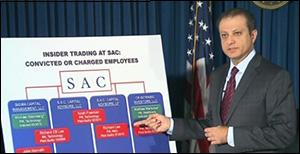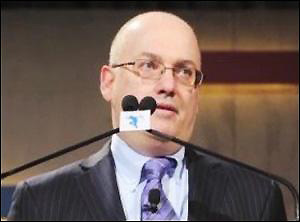By Pam Martens: July 26, 2013
U.S. Attorney Preet Bharara of the Department of Justice released a criminal indictment yesterday against one of the most well known hedge funds on Wall Street, SAC Capital Advisors. Bharara said the firm had institutionalized insider trading as a business model over more than a decade, incentivizing employees who provided hot insider tips with large bonuses, which in turn molded the company into a “veritable magnet for market cheaters.” Eight former employees have been charged and six have already pleaded guilty.
In the past, when large financial firms which hold customer assets have been charged in a criminal indictment, the company has unraveled within a brief period of time.
According to media reports, the government may seek as much as $10 billion from SAC as forfeiture for the crimes committed. That raises questions about the $187 million in charitable donations that Steven A. Cohen, owner of SAC Capital, and his wife, Alexandra, have donated to charities since 2005 through their foundation.
On July 19 of this year, Cohen himself was charged in a civil complaint by the Securities and Exchange Commission for failing to supervise two traders under his watch and prevent them from engaging in insider trading. According to the SEC, “Cohen received highly suspicious information that should have caused any reasonable hedge fund manager to investigate the basis for trades made by two portfolio managers who reported to him – Mathew Martoma and Michael Steinberg.” Instead, according to the SEC, “Cohen ignored the red flags and allowed Martoma and Steinberg to execute the trades. Instead of scrutinizing their conduct, Cohen praised Steinberg for his role in the suspicious trading and rewarded Martoma with a $9 million bonus for his work.” The company settled its civil charges with the SEC in March for $614 million. Martoma and Steinberg have pleaded not guilty.
One charity stands out in particular for largesse from the Steven A. and Alexandra M. Cohen Foundation. The oddly named Robin Hood Foundation, an anti-poverty program for New York City’s poorest residents, received just under $62 million from the Cohen foundation between 2005 and 2011. (Figures for 2012 are not yet publicly available.) The annual sums ranged from a low of $250,000 in 2005 to a high of $18,753,600 in 2007. More recently, in 2011, the Cohen donation was $13,350,000.
The nonprofit states on its web site that since 1988 it has given out grants of over $1.1 billion to fight poverty in New York City. In a video on the organization’s web site, it notes there are 1.8 million New Yorkers who are poor, or the equivalent of the fifth largest city in America.
Steven Cohen sits on the Board of Directors of Robin Hood, alongside a veritable who’s who of the hedge fund world. Hedge fund owners, many of whom are billionaires, receive a special perk in the tax code. They pay a lower tax rate than most middle class Americans. Called “carried interest,” hedge fund managers are able to treat the profits they keep from their customers’ trades as long term capital gains instead of ordinary income, which has facilitated a 15 percent tax rate. (That rate moves to a cap of 20 percent this year.)
According to Wall Street insiders, SAC charged some of the highest fees in the hedge fund industry. In addition to an annual fee of 3 percent on the customers’ assets under management, SAC charged clients as much as 50 percent of the profits it generated on trades. It kept its 50 percent of these profits, which routinely reached into the hundreds of millions of dollars, and paid tax at the rate of 15 percent to Uncle Sam, less than half the tax rate it would have paid on ordinary income.
In addition to losing this enormous base of tax revenue to help fund its own anti-poverty programs, the federal government has now spent millions of taxpayer funds investigating SAC Capital for insider trading over at least the last two and a half years. It will spend millions more as the trials move forward.
If Cohen had some idea in the back of his head that scooping up profits from insider trading and pumping a portion of the proceeds into programs for the poor is somehow a Robin Hood-esque good deed, prosecutors may have other ideas.
The folks on the other side of the trades made by SAC, when it had illegal inside information, were just as likely pension funds for teachers or fire fighters or labor unions, or mom and pop businesses, as they were the rich. (Robin Hood indeed.)
This past February, long after various SAC traders had been indicted by the Justice Department for insider trading and rumors were swirling around Steven Cohen, the Steven A. and Alexandra M. Cohen Foundation made a $17 million grant to New York University’s Langone Medical Center. In return, NYU announced the naming of the Steven and Alexandra Cohen Veterans Center for the Study of Post-Traumatic Stress and Traumatic Brain Injury.
Cohen is now the second hedge fund owner to be thoroughly discredited by the Securities and Exchange Commission and still have his name memorialized on the walls of New York University – a center of learning ostensibly charged with setting character standards for America’s young people.
According to NYU’s 2010 Spring/Summer alumni magazine, John Paulson, the hedge fund owner who played a central role in the Goldman Sachs ABACUS deal that is currently playing out in a Manhattan courtroom in the trial of Fabrice Tourre, had the first floor lobby of NYU’s Tisch Hall and an auditorium named in his honor in exchange for a $20 million gift to the Stern School of Business.
According to an SEC complaint in April 2010, Paulson helped Goldman Sachs rig an investment that was designed to fail, then shorted it. Goldman Sachs then sold the ABACUS deal to unknowing investors as a worthy investment. Investors lost approximately $1 billion while Paulson made a comparable amount.



